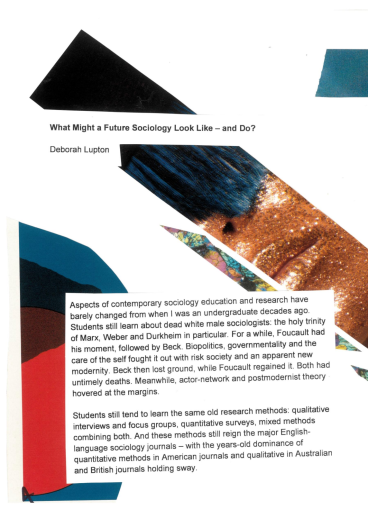This editorial featured in edition #6 of So Fi Zine. Read the full edition here.
What Might a Future Sociology Look Like – and Do?
Deborah Lupton

Aspects of contemporary sociology education and research have barely changed from when I was an undergraduate decades ago. Students still learn about dead white male sociologists: the holy trinity of Marx, Weber and Durkheim in particular. For a while, Foucault had his moment, followed by Beck. Biopolitics, governmentality and the care of the self fought it out with risk society and an apparent new modernity. Beck then lost ground, while Foucault regained it. Both had untimely deaths. Meanwhile, actor-network and postmodernist theory hovered at the margins.
Students still tend to learn the same old research methods: qualitative interviews and focus groups, quantitative surveys, mixed methods combining both. And these methods still reign the major English-language sociology journals – with the years-old dominance of quantitative methods in American journals and qualitative in Australian and British journals holding sway.
Some change is evident, however. Dave Beer has called for a punk sociology and Les Back and colleagues argue for live sociology and for lively methods. Digital sociology is slowly but surely creeping into the curriculum. Some more women and non-white scholars are now thrown into the mix in most university sociology programs (but indigenous and First Nations perspectives remain scandalously marginalised). Women’s studies is now rebranded as gender studies, thereby becoming more inclusive and responding to greater social awareness of gender and sexuality fluidities and consequent politics. There have been references to the ‘affective turn’ that has influenced the humanities and social sciences in general, involving engagement with the philosophy of Deleuze and Guattari in particular.
Building on and expanding from affect theory, more-than-human theories (also referred to as new materialisms or the posthumanities) are starting to make a move into sociological research and teaching. Alongside these perspectives, the post-qualitative approach to social inquiry is beginning to make a mark, travelling from the field of gender and education studies, where it began. And sociologists, like other researchers and scholars in the humanities and social sciences, are starting to take an interest in innovative methods for social inquiry that involve arts- and design-based approaches. Not long ago, I made the bold claim on Twitter that: ‘I think the time has come to announce a new ‘turn’ in social inquiry – the creative turn’. Responses from my followers, in the main, were affirmative.
There is a hunger for trying new ways of research in sociology and for accessing aspects of people’s lives that are often difficult to surface using conventional methods. Whenever I have used creative methods – whether with research participants or in workshops with other academics and postgraduate students – the response is overwhelmingly positive. People enjoy creating things: drawing, writing creative responses to prompts, mapping, making comic strips, bringing together images in collages or zines, making and responding to music. Researchers enjoy making with their participants and find the ennui of labouring at the coal face in the contemporary neoliberal university beginning to dissipate as they observe and feel the sparks of excitement and new ways of thing, feeling and doing that are generated with and through these encounters and research-creations. Bennett’s ‘thing-power’ is clearly in action in these moments.
Is this a manifesto for more creating and making and thinking otherwise in sociology? Yes! Will zombie sociology be content to rest in its unquiet grave, along with the dead white men? Time will tell…